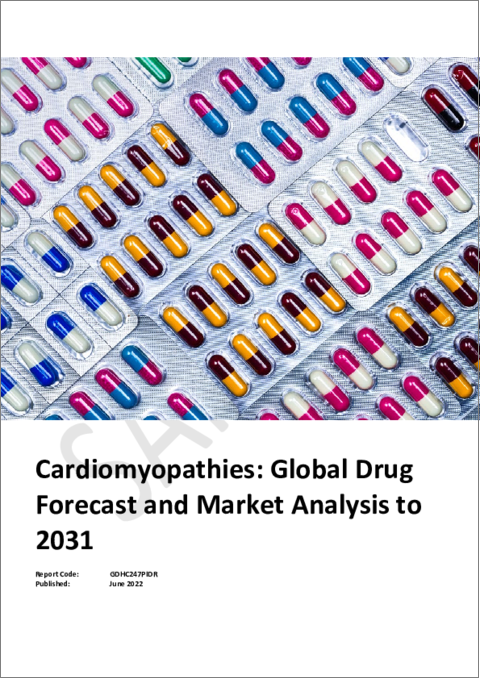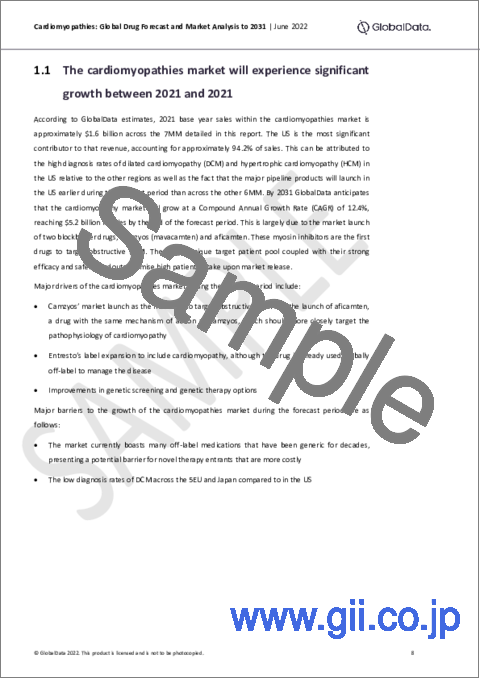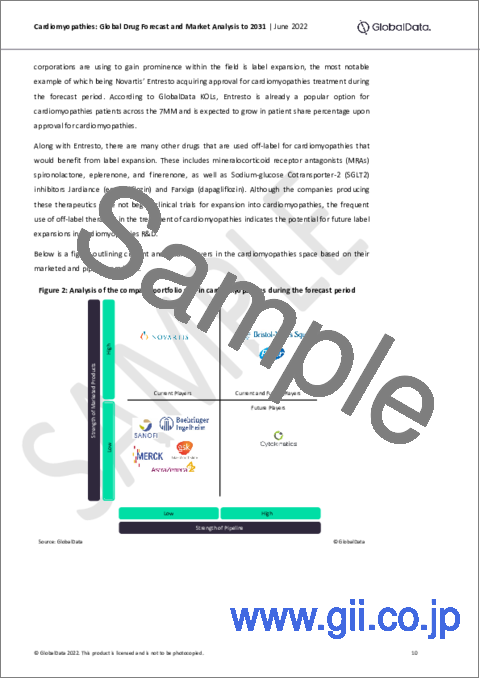|
|
市場調査レポート
商品コード
1109503
心筋症の市場規模と動向レポート:疫学とパイプライン分析、競合評価、アンメットニーズ、臨床試験戦略、予測(2021~2031年)Cardiomyopathies Market Size and Trend Report including Epidemiology and Pipeline Analysis, Competitor Assessment, Unmet Needs, Clinical Trial Strategies and Forecast, 2021-2031 |
||||||
|
● お客様のご希望に応じて、既存データの加工や未掲載情報(例:国別セグメント)の追加などの対応が可能です。 詳細はお問い合わせください。 |
|||||||
| 心筋症の市場規模と動向レポート:疫学とパイプライン分析、競合評価、アンメットニーズ、臨床試験戦略、予測(2021~2031年) |
|
出版日: 2022年06月01日
発行: GlobalData
ページ情報: 英文 101 Pages
納期: 即納可能
|
- 全表示
- 概要
- 図表
- 目次
当レポートでは、世界の心筋症市場について調査分析し、心筋症の概要、心筋症治療薬市場のトップライン、年間治療費、主要な後期パイプライン薬の予想売上高、現在の治療法とパイプラインの評価、アンメットニーズ、現在および将来の企業、10年間の予測期間における米国、5EU、日本の市場見通し、パイプライン分析等に関する情報を提供しています。
目次
目次
第1章 心筋症:エグゼクティブサマリー
- 心筋症市場は、2021~2021年の間に大幅な成長を遂げると予想されます。
- ラベルの拡大は、心筋症分野の企業の現在および将来の成長戦略です。
- 根治療法の選択肢、遺伝子スクリーニングの改善は、依然として必要な分野です。
- Camzyosが予測期間中に心筋症の売上を牽引
- 医者はどう考えるか?
第2章 イントロダクション
- 触媒
- 関連レポート
第3章 疾患の概要
- 病因と病態生理学
- 病因
- 病態生理学
第4章 疫学
- 疾患の背景
- 危険因子と併存疾患
- 世界および過去の動向
- 予測調査手法
- 心筋症の疫学的予測(2021~2031年)
- 討論
第5章 疾患管理
- 診断と治療の概要
- 疾患管理に関するKOLの洞察
第6章 競合評価
- 概要
第7章 アンメットニーズと機会の評価
- 概要
- 遺伝子スクリーニングと遺伝子治療の改善
- 予防的治療より治療的治療の選択
- 特定の標的を持つ新しい薬剤
- アミロイド心筋症患者の適切な診断と治療
第8章 研究開発戦略
- 概要
- ラベル展開
- 新規ターゲットによる薬剤の開発
- 臨床試験デザイン
- 生活の質のエンドポイント
第9章 パイプライン評価
- 概要
- 臨床開発中の有望な薬剤
第10章 パイプライン評価分析
- 概要
- 競合評価
第11章 現在および将来の企業
- 概要
- 取引動向
第12章 市場の見通し
第13章 付録
List of Tables
List of Tables
- Table 1: Cardiomyopathies: Key Metrics in the 7MM
- Table 2: Cardiomyopathies: Features and factors
- Table 3: Risk factors and comorbidities for cardiomyopathies
- Table 4: Most commonly used guidelines for cardiomyopathies by country
- Table 5: Pfizer Portfolio Assessment, 2022
- Table 6: Bristol Myers Squibb Portfolio Assessment, 2022
- Table 7: Cytokinetics Portfolio Assessment, 2022
- Table 8: Cardiomyopathies market - global drivers and barriers, 2021-2031
- Table 9: Key events impacting sales for cardiomyopathies in the US, 2021-2031
- Table 10: Cardiomyopathies Market - Drivers and Barriers in the US, 2021-2031
- Table 11: Key events impacting sales for cardiomyopathies in the 5EU, 2021-2031
- Table 12: Cardiomyopathies market - drivers and barriers in the 5EU, 2021-2031
- Table 13: Key events impacting sales for cardiomyopathies in Japan, 2021-2031
- Table 14: Cardiomyopathies market - drivers and barriers in Japan, 2021-2031
- Table 15: High-prescribing physicians (non-KOLs) surveyed, by country
List of Figures
List of Figures
- Figure 1: Global sales forecast by country for cardiomyopathies in 2021 and 2031
- Figure 2: Analysis of the company portfolio gap in cardiomyopathies during the forecast period
- Figure 3: Competitive assessment of the late-stage pipeline agents that GlobalData expects to be licensed for the treatment of cardiomyopathies during the forecast period
- Figure 4: Physical differences between a normal heart and hearts afflicted with dilated, hypertrophic, and restrictive cardiomyopathies
- Figure 5: 7MM, diagnosed prevalence of cardiomyopathies (%), men and women, all ages, 2021
- Figure 6: Sources used and not used for diagnosed prevalent cases of dilated cardiomyopathy
- Figure 7: Sources used and not used for diagnosed prevalent cases of hypertrophic cardiomyopathy
- Figure 8: Sources used for diagnosed prevalent cases of restrictive cardiomyopathy
- Figure 9: Sources used for diagnosed prevalent cases of arrhythmogenic cardiomyopathy
- Figure 10: Sources used for diagnosed prevalent cases of dilated cardiomyopathy by etiology
- Figure 11: Sources used for diagnosed prevalent cases of hypertrophic cardiomyopathy by etiology
- Figure 12: Sources used for diagnosed prevalent cases of restrictive cardiomyopathy by etiology
- Figure 13: Sources used for diagnosed prevalent cases of arrhythmogenic cardiomyopathy by etiology
- Figure 14: 7MM, diagnosed prevalent cases of cardiomyopathies in 2021, men and women, N, all ages
- Figure 15: 7MM, diagnosed prevalent cases of cardiomyopathies by subtype, men and women, all ages, N, 2021
- Figure 16: 7MM, age-specific diagnosed prevalent cases of cardiomyopathies, men and women, all ages, N, 2021
- Figure 17: 7MM, diagnosed prevalent cases of cardiomyopathies by sex, all ages, N, 2021
- Figure 18: 7MM, Diagnosed Prevalent Cases of Cardiomyopathies by Etiology, Men and Women, All Ages, N, 2021
- Figure 19: 7MM, diagnosed prevalent cases of ischemic dilated cardiomyopathy, men and women, all ages, N, 2021
- Figure 20: Sample cardiomyopathy treatment paradigm
- Figure 21: Unmet needs and opportunities in cardiomyopathy
- Figure 22: Overview of the development pipeline in cardiomyopathies
- Figure 23: Key late-stage trials for the promising pipeline agents that GlobalData expects to be licensed for cardiomyopathy in the 7MM during the forecast period
- Figure 24: Competitive assessment of the late-stage pipeline agents that GlobalData expects to be licensed for the treatment of cardiomyopathies during the forecast period
- Figure 25: Competitive assessment of the marketed and pipeline drugs benchmarked against the standard of care: ACE inhibitors, ARBs, ARNi (Entresto), beta blockers, MRAs, SGLT2 inhibitors, antiarrhythmics, and calcium channel blockers
- Figure 26: Analysis of the company portfolio gap in cardiomyopathies during the forecast period
- Figure 27: Deal-Making Trends, 2017-2021
- Figure 28: Global (7MM) sales forecast by country for cardiomyopathies in 2021 and 2031
- Figure 29: Sales forecast by class for cardiomyopathies in the US in 2021 and 2031
- Figure 30: Sales forecast by class for cardiomyopathies in the 5EU in 2021 and 2031
- Figure 31: Sales forecast by class for cardiomyopathies in Japan in 2021 and 2031
What is Cardiomyopathy?
- Heterogenous collection of pathologies; normal heart muscle, stiff, thin, or fills with substances that do not belong
- Dilated CM, Hypertrophic CM (Obstructive/Non-Obstructive), RCM, ACM
- Symptoms: Shortness of breath/trouble breathing, fatigue, swelling in the ankles, feet, legs, abdomen and veins, dizziness, light-headedness, fainting during physical activity, etc.
How is Cardiomyopathy managed?
- No treatment
- Generics: Beta blockers, ACE inhibitors, ARBs, antiarrhythmics, calcium channel blockers
- Branded: SGLT2 inhibitors
- Surgically implanted devices, alcohol ablation, etc.
Why Cardiomyopathy?
- First report covering CM
- New pipeline products that are expected to be blockbusters:
Camzyos (mavacamten) & aficamten
- First drugs to be indicated for obstructive HCM
- First myosin inhibitors
- More closely address underlying pathophysiology of the disease
GlobalData projects the therapeutic market for cardiomyopathies within the 7MM will grow from $1.6B in 2021 at a compound annual growth rate (CAGR) of 12.4% to $5.2B by 2031.
Main drivers of growth:
- Camzyos (Bristol Myers Squibb) and aficamten (Cytokinetics) launch across the 7MM
- Entresto (sacubitril + valsartan) label expansion to include CM
KEY QUESTIONS ANSWERED
Treatment for cardiomyopathies should improve over the forecast period, but unmet needs remain.
- Which unmet needs are the most pressing in the 7MM?
- Where should pharmaceutical companies focus drug development efforts in order to become a significant player in the space?
Novel drugs are being developed, with 65 pipeline candidates from pre-registration to Phase III.
- What are the most promising late-stage candidates and how much they expected to generate over the forecast period?
- What do KOLs say about their clinical and commercial positioning?
An increasing number of companies are investing in cardiomyopathies drug development.
- Which have been historically the companies leading the way?
- What new companies are emerging in the space?
Key Highlights
- The cardiomyopathies market is currently highly genericized and contains many off-label medications, which provide affordable options with limited side effects. These factors create a stiff barrier for entry of novel therapeutics, but pipeline therapeutics will find success due to strong efficacy and safety profiles and that they are cardiomyopathy-specific therapeutics, rather than general cardiovascular drugs.
- There is an increased focus on genetic screening and developing genetic therapeutics because cardiomyopathies are often inherited rather than acquired. Emprumapimod will be the first marketed genetic therapy, as it targets patients with DCM due to a lamin gene mutation. However, this drug will not generate significant revenue given the small size of the target patient population.
- There is not a cure for cardiomyopathies, instead the disease symptoms are managed with generic cardiovascular drugs. This remains an area of unmet need in the cardiomyopathies space.
- Camzyos was the first novel therapy launched in the cardiomyopathies market in several decades when it was marketed in 2022. Thus, there is a need for novel therapies in this space, which should be met by the extensive pipeline.
Scope
- Overview of cardiomyopathies including epidemiology, disease etiology and management.
- Topline cardiomyopathy drugs market revenue (including off-label adjunct therapeutics used for metabolic benefits), annual cost of therapy, and anticipated sales for major late-stage pipeline drugs.
- Key topics covered include assessment of current and pipeline therapies, unmet needs, current and future players and market outlook for the US, 5EU, and Japan over the 10-year forecast period.
- Pipeline analysis: Emerging novel trends under development, and detailed analysis of late-stage pipeline drugs.
- Analysis of the current and future market competition in the global cardiomyopathy therapeutics market. Insightful review of the key industry drivers, restraints and challenges.
Reasons to Buy
The report will enable you to -
- Develop and design your in-licensing and out-licensing strategies, using a detailed overview of current pipeline products and technologies to identify companies with the most robust pipelines.
- Develop business strategies by understanding the trends shaping and driving the global cardiomyopathy therapeutics market.
- Drive revenues by understanding the key trends, innovative products and technologies, market segments, and companies likely to impact the global cardiomyopathies market in the future.
- Formulate effective sales and marketing strategies by understanding the competitive landscape and by analyzing the performance of various competitors.
- Identify emerging players with potentially strong product portfolios and create effective counter-strategies to gain a competitive advantage.
- Track drug sales in the global cardiomyopathy therapeutics market from 2021-2031.
- Organize your sales and marketing efforts by identifying the market categories and segments that present maximum opportunities for consolidations, investments and strategic partnerships.
Table of Contents
Table of Contents
1 Cardiomyopathies: Executive Summary
- 1.1 The cardiomyopathies market will experience significant growth between 2021 and 2021
- 1.2 Label expansion is a current and future growth strategy for companies in the cardiomyopathies space
- 1.3 Curative therapy options and improvements in genetic screening remain areas of need
- 1.4 Camzyos to drive cardiomyopathy sales during the forecast period
- 1.5 What do physicians think?
2 Introduction
- 2.1 Catalyst
- 2.2 Related reports
3 Disease Overview
- 3.1 Etiology and pathophysiology
- 3.1.1 Etiology
- 3.1.2 Pathophysiology
4 Epidemiology
- 4.1 Disease Background
- 4.1.1 Risk Factors and Comorbidities
- 4.2 Global and Historical Trends
- 4.3 Forecast Methodology
- 4.4 Epidemiological Forecast for Cardiomyopathies (2021-2031)
- 4.5 Discussion
5 Disease Management
- 5.1 Diagnosis and treatment overview
- 5.2 KOL insights on disease management
6 Competitive Assessment
- 6.1 Overview
7 Unmet Needs and Opportunity Assessment
- 7.1 Overview
- 7.2 Improvements in genetic screening and gene therapies
- 7.3 Curative rather than preventative therapy options
- 7.4 Newer drugs with specific targets
- 7.5 Adequate diagnosis and treatment of amyloid cardiomyopathy patients
8 R&D Strategies
- 8.1 Overview
- 8.1.1 Label expansion
- 8.1.2 Development of drugs with novel targets
- 8.2 Clinical trial design
- 8.2.1 Quality of life endpoints
9 Pipeline Assessment
- 9.1 Overview
- 9.2 Promising drugs in clinical development
10 Pipeline Valuation Analysis
- 10.1 Overview
- 10.2 Competitive assessment
11 Current and Future Players
- 11.1 Overview
- 11.2 Deal-making trends




